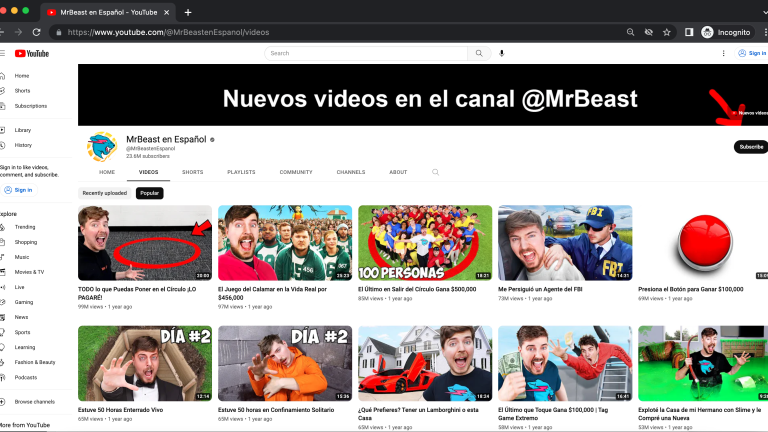In the spring of 2021, Farbod Mansorian temporarily moved from his home in Los Angeles to Greenville, North Carolina to pitch one of YouTube’s biggest stars an unexpected idea: taking his act into Spanish.
Jimmy Donaldson, known on YouTube simply as MrBeast, runs the fifth-biggest channel on the platform, with over 130 million subscribers — all tuning in for English-language content. Mansorian’s pitch to MrBeast was to expand beyond English through dubbing, and repackage his content for the other 87% of the world.
It has been a remarkably successful pitch. Mansorian’s company, Unilingo, brought MrBeast onto its roster a few weeks later — it now has similar deals with major channels like Dude Perfect, PewDiePie, and Jubilee. More recently, Unilingo onboarded its first TikTok creator (Mansorian did not disclose their name, but said the move was part of the company’s expansion into short-form video). Mansorian estimates Unilingo has generated nearly $10 million for creators by re-releasing their content, dubbed and circulated in other languages.
According to YouTube, as much as two-thirds of the total watch time for a creator’s channel comes from outside their home region. For Mansorian, the business opportunity is clear. “If you take the top 10,000 YouTube videos by performance and dub them in 20-plus languages, you could easily unlock an additional half a trillion to a trillion views,” he told Rest of World.
Mansorian and his company lead a growing social media-dubbing industry focused entirely on creators. In India, YouTuber Harsha Sai has reached an additional 12 million subscribers by dubbing videos from his native Telugu in Tamil and Hindi. The Japan-based YouTube channels Pokémon Asia Official (Hindi) and Pokémon Indonesia have drawn 15 million subscribers by uploading episodes dubbed in Hindi and Bahasa Indonesia. The 9-year-old Russian YouTuber, Like Nastya, has created nine different dubbed channels, expanding into Bahasa Indonesia, Korean, and Arabic to reach over 100 million non-Russian subscribers. It’s a global phenomenon, and one that’s taking place with minimal help from the established language service providers (LSPs) that dominate the entertainment industry.

“We just started doing this six months ago, and it’s crazy how viral some of these videos have been,” MrBeast had said on a podcast in March 2022, describing his Spanish-language channel titled MrBeast en Español. It currently has 23 million subscribers, with its most popular videos nearing 100 million views. Unilingo typically charges an upfront translation fee, and takes a 10% cut on future ad revenues from the dubbed channels.
The company works hard for those extra views, often paying top dollar for famous voice actors. For MrBeast en Español, Mansorian hired one of the voice actors who had done the Spanish-language dubs for the Spider-Man films, adding another layer of intrigue. Unilingo also contracted Junko Takeuchi, who voices the lead in the anime series Naruto, to be the Japanese voice of MrBeast. “There was a lot of skepticism in the beginning,” Mansorian said, describing the six-month process of convincing her to take the gig. “It wasn’t easy.”
One of the earliest YouTubers to create dubbed content on the platform was Derek Muller. He runs the popular, science-focused channel Veritasium, which has over 13 million followers. In 2018, Muller hired Unilingo to dub his English-language videos in Spanish, and launched Veritasium en español, separate from his main channel. In the five years since, Veritasium’s Spanish channel has earned Muller more than $50,000 in additional revenue, and been viewed more than 200 million times. The Spanish version of his viral video about shade balls in a reservoir has over 16 million views. Unilingo now handles dubbing and content operations for Veritasium in seven languages.
YouTube has been developing systems to support multilingual content for years. In 2021, Google began testing a feature called “audio tracks,” which allows viewers to choose between multiple dubbing options on a single video. MrBeast was part of the original tests in Spanish, and testing has expanded gradually — in December 2022, audio tracks were launched for select videos in regional Indian languages. Last week, YouTube announced that it would be bringing the feature to all creators. Currently, many YouTube creators often upload a separate video — on dedicated dubbing channels — for every audio language option. The wide release of audio tracks has the potential to change this precedent, though many may still choose to game YouTube’s recommendation algorithms by releasing dubs separately.
$50,000 The amount of money Veritasium’s Spanish-language channel has earned in revenue.
Popular creators who refuse to translate their work run the risk of others doing it for them — sometimes stealing ad revenue in the process. Unauthorized translations, known as “fandubs,” are typically shared in local languages without the original creator’s knowledge or participation. One of Unilingo’s first tasks when a new creator is brought on board is to purge these “pirate dubs,” which sometimes monetize their content with YouTube ads, merchandise sales, or even sponsorships. Prior to launching the PewDiePie en Español channel, Mansorian had shut down a fandub channel with 100,000 subscribers by submitting a copyright removal request to YouTube .
Fandubs can cross into copyright infringement when created for profit instead of simply for the entertainment of other fans. But fandubbing can also work as an unofficial localization strategy. “The popularity of fandubbing seems to reflect an audience need for the dubbing of YouTube content,” Seryun Lee, a research professor who specializes in translation and intercultural studies at the Hankuk University of Foreign Studies, told Rest of World. Lee is quick to point out that fandubs are not without their advantages for popular YouTubers. In addition to proving the demand for various languages, some in the entertainment industry even encourage fandubs in order to take advantage of the free labor.
“I have heard of YouTubers and copyright holders temporarily ignoring fan-made versions of their videos, as dedicated fans can [produce] more engaging translations, and circulating content through such versions can be an effective marketing strategy,” Lee said.
The market for YouTube dubbing is small enough that it’s been mostly ignored by the LSPs that handle translations for the entertainment industry. The translation services market is growing fast: According to one estimate, it may reach $47.21 billion by 2030, inflated by new demand from streaming services. But those contractors are still struggling to keep pace with orders and retain translator talent due to falling wages, as Rest of World has previously reported.
In particular, established LSPs aren’t sure YouTubers can afford their rates. “It’s going to come down to workflow and pricing. You know, I think the way that YouTube content is created is just so different,” Louise Callcott-Stevens, the CEO of EarCandy, a South African localization provider that does work for Netflix and Paramount, told Rest of World. EarCandy has yet to do business with independent YouTubers, but Callcott-Stevens sees the rise of specialized providers in Los Angeles as a sign the trend may go global in the coming year.
“I think people are realizing that they cannot just stick to an elite audience speaking English.”
For now, international LSPs are often too expensive for YouTube productions, and relationships with social media creators can be more high-touch, requiring trust-building and education about the dubbing process. Mansorian sees this margin as his opportunity to capture. For instance, Netflix’s vendor rate card currently lists $90 for 15 minutes of dubbed content. “We are providing dubbing to creators at a discount,” Mansorian said.
Still, Callcott-Stevens sees potential in YouTube language services. EarCandy’s sales and business development teams have started to pursue contracts with agencies that use YouTube. “We are behind the curve,” she said, “and I do see that changing.” In 2023, MrBeast launched his own multilingual dubbing company, Creator Global, to cash in on the opportunity.
In the meantime, independent voice artists like Barath Raj are taking advantage of the chance to make money dubbing for YouTubers. Raj began his career as a journalist in Tamil media. Over the past couple of years, he has been voicing audio books, and producing audio shows to break into the podcasting industry. He’s now the voice of Anbudan Ashish Vidyarthi, the Tamil-dubbed channel of the popular YouTuber and actor Ashish Vidyarthi.
“I think people are realizing that they cannot just stick to an elite audience speaking English, which is not the mother tongue for all Indians actually,” Raj told Rest of World. YouTubers like Vidyarthi, who share vlogs and motivational videos, are using regional dubs to find newer audiences. “In that aspect, budding dubbing artists like me get a chance,” Raj said.
Dubbed videos uploaded to the main channel of a popular creator rarely find success, since most subscribers have already seen the original video. And because YouTube’s algorithm rarely recommends content across language barriers, many creators don’t see value in subtitling. “To reach more audience[s], I felt subtitles would not work at all,” Telugu YouTuber Harsha Sai told Rest of World.
Sai, who started out in late 2020, is one of the few Indian YouTubers who have been dubbing content in multiple Indian languages. To reach Tamil and Hindi audiences, he launched two separate dubbed channels. He also hired a family friend who ran a dubbing studio to voice the videos. Today, the cumulative subscriber count of Sai’s Tamil and Hindi-dubbed channels is over 12 million, bigger than his 8-million-strong Telugu main channel.
“Whenever I go to other regions like Tamil Nadu, and other parts in the north of India like Mumbai, people recognize me and get excited,” Sai said. “The only problem is I can’t reply in their language.”



